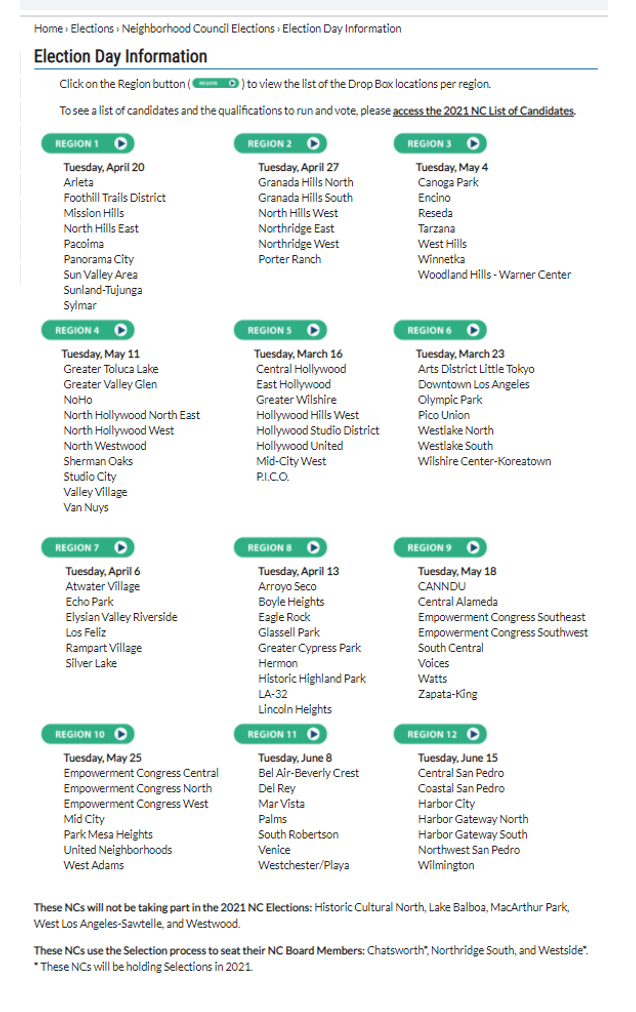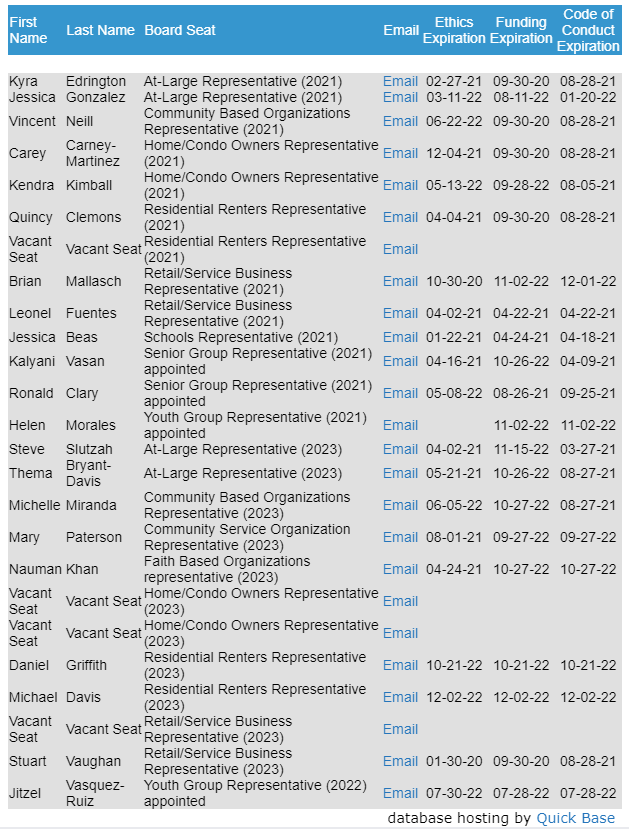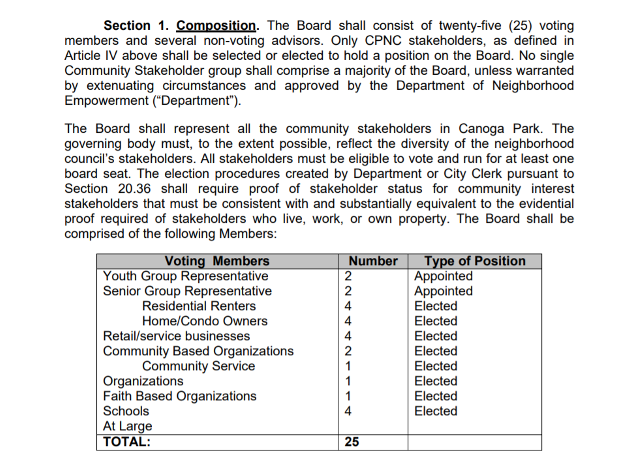CommentsNEIGHBORHOOD POLITICS-As I write this, Neighborhood Councils that have elections planned in 2021 for their communities, have already begun elections for their Board members.
This is one of the issues that I have with the Neighborhood Council system: I believe all Neighborhood Councils should be required to run their Elections through the designated City Governmental body – in the case of this year, through the Office of the City Clerk.
Neighborhood Councilmembers are considered Elected Officials within the City of Los Angeles government. Therefore, it makes sense they should be kept distant from the election process -- just as you would expect our Mayor, our City Attorney, our Controller, and our City Councilmembers to be distanced from their election process.
Here is a list of the days when the Neighborhood Council Elections will be held in each community:

You will notice at the bottom of the page which Neighborhood Councils will not be participating in the 2021 elections.
Information related to Neighborhood Council Elections including the chart above can be found on the City Clerk’s website here.
Why do I believe Neighborhood Councils should represent residents only and that only residents should be Board members?
Let’s start with a brief definition on what a Neighborhood Council is according to the City of Los Angeles’ website.
General Information:
Neighborhood Councils are the closest form of government to the people. They are advisory bodies, who advocate for their communities with City Hall on important issues like development, homelessness, and emergency preparedness. Neighborhood Councils are part of the Los Angeles City government, and have annual budgets funded by taxpayer dollars. Neighborhood Council board members are City officials who are elected by the members of their local communities, but they donate their time as volunteers. The Neighborhood Council system was established in 1999 as a way of ensuring that the City government remains responsive to the different needs and lifestyles of Los Angeles’ rich variety of communities. There are currently 99 Neighborhood Councils in Los Angeles, each serving about 40,000 people.
For rosters and meeting schedules, please visit: https://empowerla.org/councils/”
What is the definition of a stakeholder in a Neighborhood Council?
“WHO CAN PARTICIPATE?
Another unique feature of LA’s Neighborhood Council system is its broad, inclusive definition of stakeholdership. Unlike other government officials, who are elected by residential stakeholders of the area they serve, Neighborhood Councils are open to participation by anyone who is part of the fabric of daily life in a community. This includes those who live, work, or own property or a business there.
Also included are ‘community interest stakeholders,’ who have some type of ongoing, substantial involvement within a Council’s boundaries, such as students in a local school, or the congregation of a local church.
Board members – and candidates, and voters – need not be U.S. citizens or legal U.S. residents to qualify. Participation is also open to the formerly incarcerated.”
Notice in the above definition, that a stakeholder – in other words – someone who can vote in a Neighborhood Council Election or even run for a Neighborhood Council Board position -- can be not only a resident (live), but someone who works, owns property, attends school, attends church, or in other definitions, is involved with a community group such as a nonprofit.
Considering that Neighborhood Councilmembers have a substantial budget, I think they should be able to spend that budgeted money in the best interests of the residents of their communities. If this means funding Emergency Preparedness events, beautification projects, or donation to nonprofits that will be in the best interest of the community, then so be it. Residents who live in that community should be able to vote on what is in their best interest.
The Homeless Crisis and the COVID-19 Pandemic:
Today, we are facing dual crisis – the ongoing homeless crisis and the 2020 and ongoing COVID-19 pandemic. Homeless people are considered even more vulnerable to catching this illness which is devastating to our Los Angeles communities. In my opinion, local residents should be deciding where the homeless could be potentially housed during this pandemic; how they could allocate some of their funds to help the homeless, the food insecure, or to even assist our first responders, our hospital employees, or help those necessary people who work in our local businesses, including pharmacies, grocery stores, and restaurants who managed to stay open.
Safe Parking:
An issue of local importance for example, is designating where it is safe for homeless people who live in their cars or in recreational vehicles to park at night. Where will there be bathrooms and sanitation for these currently “unhoused residents”?

Recently, the Los Angeles Department of Transportation Commission held a public hearing regarding using a City owned parking lot in Canoga Park for “Safe Parking” at night.
“ACTION ITEM 9. Authority to Issue a Revocable Permit to North Valley Caring Services to Operate a Safe Parking Program and Adjust Operating Hours on Municipal Lot No. 704 in Canoga Park”
It is my understanding that during the comment period on this agenda item, that the item would move to the Canoga Park Neighborhood Council.
The Canoga Park Neighborhood Council:
First, this agenda item went to the “CANOGA PARK NEIGHBORHOOD COUNCIL PLANNING AND LAND USE COMMITTEE,” Wednesday, January 20, 2021 at 6:30 PM:
“4. PRESENTATION: Laura Rathbone with North Valley Caring Services to present operation plan for Homeless SAFE Parking proposed for 7134 Jordan.”
What was mind boggling to me when I attended this meeting through a ZOOM meeting process, that the members of this committee, with the exception of one, that were in attendance, are all business owners in the community – only one was a Canoga Park resident.
But what was even more astonishing was that I did not hear any Canoga Park residents – especially the residents who live next to this parking lot on this ZOOM call. Why not?
When I was a Board member of the West Hills Neighborhood Council, we would ask an applicant for a project – whether it was a development or even a cell phone tower – to notice our meeting on the issue to the residents within 500 feet. Shouldn’t this be the responsibility of all Neighborhood Councils – to request or post a notice to all residents within 500 feet (or more) of a project a notice of their Board’s or their Committee’s agenda?
That item has now moved to the full Canoga Park Neighborhood Council for their Board meeting on January 27, 2021:
“i) PRESENTATION: Laura Rathbone with North Valley Caring Services to present operation plan for Homeless SAFE Parking proposed for 7134 Jordan, Los Angeles City Parking Lot #704.
The above link will take you to the list of 99 Neighborhood Councils. There is information on each Neighborhood Council link related to their meeting dates, their Board members, and when their terms expire.
Canoga Park Neighborhood Council:
For example, you can see by this list below which Board members in Canoga Park are up for reelection:
“Board Members

What else does this Board member roster tell you? It tells you the different types of Board members make up the Canoga Park Neighborhood Council.”
Why is this important? Because each Neighborhood Council can write their own Bylaws and to choose the number of “Stakeholder seats” are on their Board.
Canoga Park Neighborhood Council Bylaws:
This is how the Canoga Park Neighborhood Council defines a Stakeholder:
“STAKEHOLDER Neighborhood Council membership is open to all Stakeholders. Stakeholders shall be defined and neighborhood council membership will be open to all those who live, work, or own real property in the neighborhood and also to those who declare a stake in the neighborhood as a community interest stakeholder, defined as a person who affirms a substantial and ongoing participation within the Neighborhood Council’s boundaries and who may be in a community organization such as, but not limited to, educational, nonprofit, and or/religious organizations. The CPNC shall not discriminate against any individual or group on the basis of race, religion, color, creed, national origin, ancestry, sex, sexual orientation, age, disability, marital status, homeowner/renter status, income, or political affiliation.”
This is how the Canoga Park Neighborhood Council defines their Governing Board:
“GOVERNING BOARD
The Governing Body of the organization shall be the Board of Directors ("Board"). The Board is empowered to make decisions on behalf of the CPNC.
CPNC Approved Bylaws 06162020

From the above table, you can see that only eight Board members of the Canoga Park Neighborhood Council should represent Residential Renters, Home / Condo Owners in Canoga Park. This gives the balance of power to businesses and non-profit representatives who may not live in Canoga Park.
West Hills Neighborhood Council Bylaws:
For comparison, this is what the West Hills Neighborhood Council says about Board members:
“ARTICLE V
GOVERNING BOARD
The Board of Directors (or “the Board”) shall be the governing body of the WHNC within the meaning of that term. Section 1: Composition - The WHNC Board shall consist of twenty-five (25) Directors (or Board Members) elected by the stakeholders on an “at-large” basis. The Board shall not include more than four (4) Directors who do not live, work, or own property in West Hills.”
So, let us look at that – West Hills only allows four members who do not live work, or own property on their Board. To the best of my knowledge, there were only three Board members until recently who were not currently West Hills’ residents. I believe that all three were former residents, who either, work, own property, or are members of a local nonprofit.
Some thoughts for the future of Neighborhood Councils:
- After the 2021 Neighborhood Council Elections, change the definition of a Stakeholder to residents only. This could include the homeless and those in temporary shelters.
- For Fiscal Year 2021 – 2022: The City Council and the Mayor should make Charter reforms that not only change the definition of Neighborhood Council stakeholders to residents only, but they should also define how a Neighborhood Council can spend their Budget. They need to consider the Budget shortages that the City of Los Angeles is facing today. For example, what City Services including LAPD and LAFD are being cut back due to the Budget due to the COVID – 19 crises.
- Can Controller Ron Galperin audit all of the Neighborhood Councils expenditures for the 2019 – 2020 v the 2020 – 2021 Budgets to determine how the various Neighborhood Councils are spending their Budgets? Can his department define “Necessary Expenditures” like paying for websites, ZOOM meeting tools, Contracted Labor, Storage, Outreach, and Neighborhood Purposes Grants? Are any of the Neighborhood Councils spending their funds frivolously? Former Controller Wendy Greuel audited the Neighborhood Councils, and she found some major issues.
“Greuel calls for greater scrutiny of neighborhood councils' spending.”
In conclusion:
Our City of Los Angeles is run by the business community. For example, here in the Valley, we have the immensely powerful Valley Industry Commerce Association (VICA). We have the Valley Economic Alliance. We have many Chambers of Commerce including one for West Hills / Canoga Park.
Unions have their representation. Lawyers have the various local Bar Associations. Physicians and Dentists have professional organizations. Some neighborhoods have Homeowners Organizations. Teachers have the California Federation of Teachers or even the American Federation of Teachers. The list goes on. . .
But who represents the Residents of our communities with the exception of our City Councilmembers and their staffs?
Therefore, I am calling for Charter reform so that Residents have a voice in City Government – not to “Empower” the businesses and the nonprofits that already have powerful alliances.
And on a final note, I would like to see our Neighborhood Councils broken down by large geographic areas. For example, if there are 25 Board members, I would like to see a resident who represents each of 25 “Neighborhoods” in that community.
(Chris Rowe, a former health care employee who has worked at Northridge Hospital, Tarzana Medical Center, and West Hills Hospital has a B.S. in Health Education. She is a 42-year resident of West Hills. She has written for the Los Angeles Daily News, RonKayeLA.org; OurLA.org; and CityWatch. She has a blog on the USC/Annenberg Center for Health Journalism website and can be reached at [email protected]) Edited for CityWatch by Linda Abrams.






